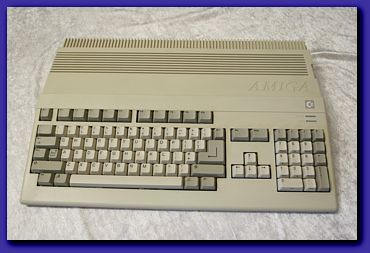
Amiga 500
The Amiga 500 was the first consumer priced Amiga after the Amiga 1000
which was considered a business machine. Commodore was already suffering
with a bad economy when this was released and all the Amigas wasnt marketed
as much as previous Commodore machines. The Amiga 500 became very successful,
especially in Europe where people saw its full potential with its 4096 color
palette, many different resolution modes from Denise (Video Control Chip) and
4 channels of real sample waveform playback.
Because of the brilliant custom chipset the Amiga was very much a multitasking
computer and enabled a lot of cool things to be done in graphics. The memory controller
and graphics blitter was called Fat Agnus and had a brilliant set of memory operations
that enabled games to use something called BOBs (Blitter Object) instead of traditional sprites.
The Amiga 4 channel MOD music that the sound chip, codenamed Paula, could produce - became an all
time hit and all the games got a serious facelift enabling new type of gameplay as well. Although
any 3D graphics had to be rendered by the CPU/Blitter we now saw the first filled polygon
games compared to the simple wireframe versions on the C64 (Elite being a prime
example of that). The 16 bits Motorola 68000 with its 7 MHz was quite a bit faster.
The Amiga 500 had a lot of expandability options as well most notably the memory
expansion slot in the bottom of the computer and the sidecar slot where you could hook
e.g. harddisks. Sidecar units made the Amiga500 a very wide computer on the desk and
it looked pretty hitech when you had extra pheripals hooked up everywhere. The Amiga 500
had a built in floppy disk and used 3.5" disks with 880kb capacity. The machine itself
booted up to a picture of a hand holding a floppy with the words Workbench on. The user
had to plop in a disk to boot the OS. This was different from earlier Commodore machines
that were in many ways "instant on" machines with everything in ROM. There were a lot of
things in ROM on the Amiga too, it only didnt have a disk operating system ready and
enabled users to "boot" directly into games instead of bringing up the workbench first.
Amiga 500 on Old-Computers.com Online Museum
My Collection
In my teens I saved up for an Amiga 500 after seeing an Amiga 1000 in the computer shop I
worked in. It was a major upgrade although when the PC came around I sold my Amiga. The one
I have in my collection was bought on ebay UK and has not yellowed much at all although the
tab key has come loose (key still works though). It came complete in the Screen Gems package
which bundles some games and Deluxe Paint II which was very popular drawing software at that
time. My A500 was made in Hong Kong, although I am uncertain if they had production other
places as well.
Serial Number: 216061


